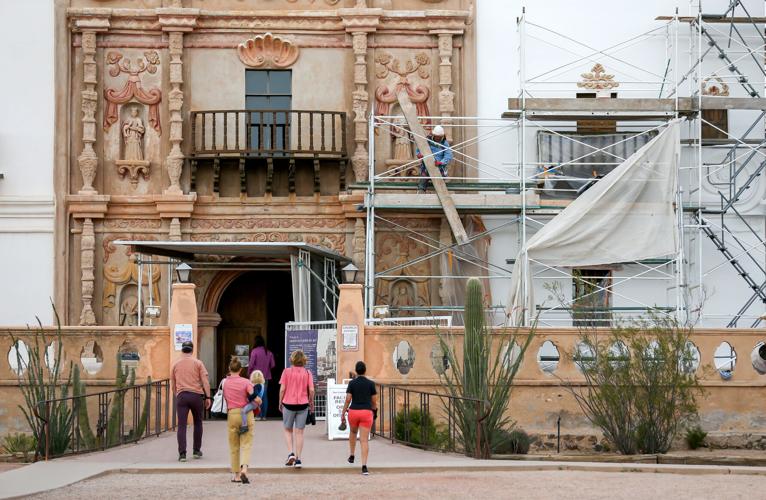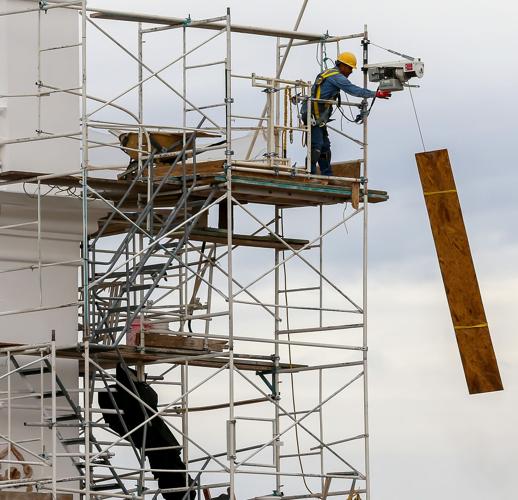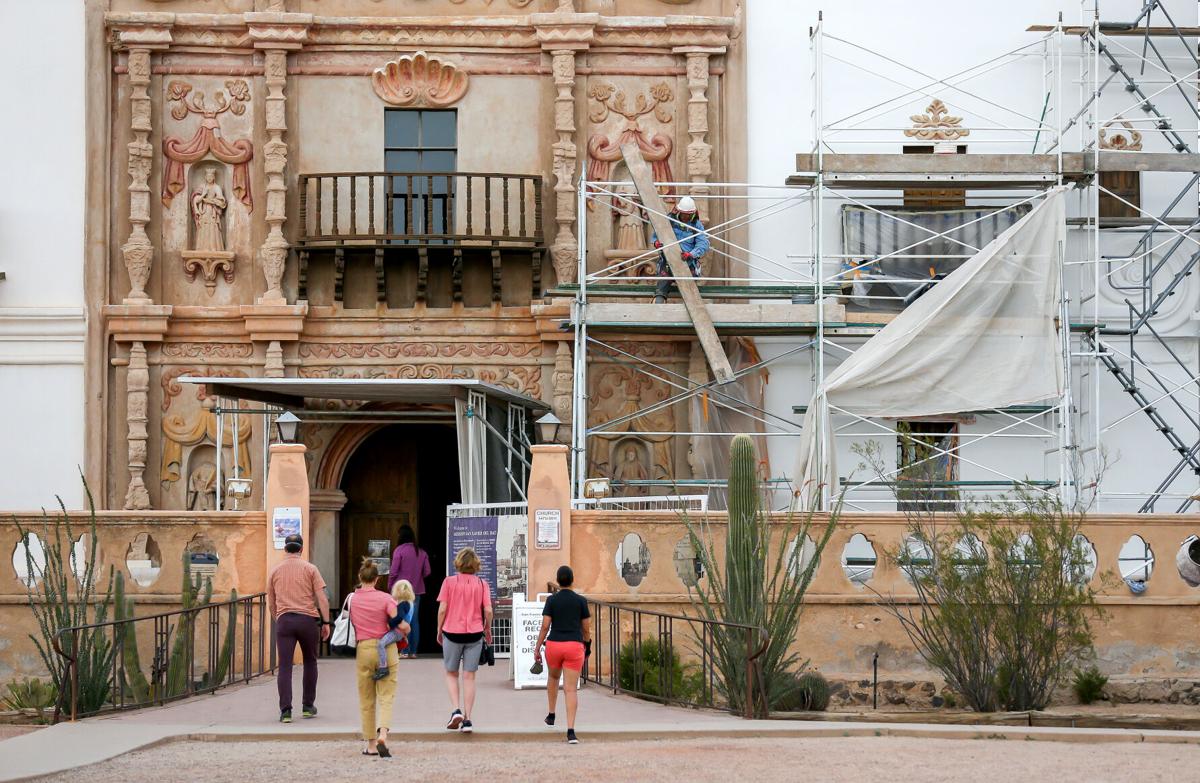COVID-19 concerns will keep worshipers out of the main chapel at San Xavier Mission on Easter Sunday, but at least the view from in front of the church should be greatly improved.
Just in time for Holy Week, the historic building is expected to be free of construction scaffolding for the first time in more than a year.
Workers could be seen taking down some of the platforms last week, revealing as they went the gleaming white surface of the newly refinished east tower.
Crews have spent the past year removing mid-20th-century, cement-based plaster from the tower’s exterior and replacing it with traditional lime-washed plaster mixed with cactus juice, which allows the walls to breathe and release moisture.
The finished product is so clean and white it’s almost hard to look at in direct sunlight. The west tower, which was resurfaced more than a decade ago, now looks vaguely peach colored by comparison.
“It’s sort of the color of sandy dust,” said Starr Herr-Cardillo, conservation project manager for Patronato San Xavier, the nonprofit that oversees preservation and fundraising for the almost-240-year-old building on Tohono O’odham land.
Herr-Cardillo expects the east tower to gradually turn the same dusty shade, as it takes on its own layer of fine, windblown Sonoran grit.
It could take a year or so, she said, but “I’m sure it’s all going to match some day.”
A fix for a fix
The more than $2 million east tower project began in 2014 with repairs to the foundation and lower walls. The second phase was put on hold in 2018 and resumed in February 2021, once additional funding was secured.
“This very major project is now at an end,” said Miles Green, Patronato’s executive director.
That’s welcome news to San Xavier Pastor William Minkel — better known as Father Bill — who said he was hoping the scaffolding would be down by Easter but wasn’t holding his breath.
“It should be nice,” he said, as he greeted visitors in front of the church on Monday.
In the 1940s and 1950s, the walls of the mission were covered with concrete plaster made from Portland cement in an effort to protect it. Decades later, caretakers realized the Portland cement actually trapped moisture, damaging the bricks and masonry underneath and causing sheets of plaster to fall from the walls and ceiling.
With the completion of the east tower, the only large patch of concrete plaster left is on the mission’s ornate facade, where it covers delicate statues and some of the original, painted decoration from when the mission was first built in the late 18th century.
Green said Patronato hopes to begin the process of removing the Portland cement from the facade in the fall of 2023, once the organization raises the necessary funds and assembles an expanded team of conservators to get the work done as quickly as possible.

A construction crew worker lowers a piece of wood while dismantling the scaffolding on San Xavier Mission.
Also next year, Patronato hopes to erect scaffolding inside the main chapel so experts can clean and restore the artwork at the highest point of the church’s dome.
Those platforms will be placed high above the floor of the chapel and should not interrupt services or obstruct views of the main altar, Herr-Cardillo said.
Conservators will access the interior scaffolding from the roof of the church, through a small pair of decorative windows high up in the dome.
Like with the facade, Green said they hope to bring in a trained crew of up to five additional people so the dome can be completed more quickly, perhaps in as little as three months.
Work on the dome and the facade is expected to cost roughly $1 million.
Later this year, Herr-Cardillo said, conservators plan to practice their plaster removal and restoration techniques on a 6-by-10-foot “test panel” located somewhere on the facade low enough to be reached with their mobile, in-house scaffolding.
Eventually, they hope to remove all of the concrete plaster from the facade and stabilize the original material underneath, but there are no plans to fix any earlier damage, such as the statue with the missing head.
Herr-Cardillo said there are no photographs showing what the statue looked like when it was whole, so they couldn’t recreate it even if they wanted to. “You want to minimize conjecture as much as you can,” she said.
COVID-19 cautious
Father Bill knows there is a lot of work involved in maintaining a church that’s also a National Historic Landmark dating back to 1783. He’s just glad to hear that the next round of preservation projects won’t be starting right away.
He said he requested as much from Patronato: “I asked, ‘Can we have one 12-month period where we don’t have any scaffolding?’”
Minkel joined the mission in the fall of 2019, about four months before the COVID-19 pandemic hit. He soon found himself canceling Easter services and closing the church altogether in 2020 to keep the virus from spreading.
“That was so bizarre to be in a church at Easter and not have a service,” he said.
Last year, church members celebrated the resurrection outdoors in the mission’s rear courtyard. Beyond word of mouth, they didn’t really publicize the event in hopes of keeping the crowd small and local.
Since COVID-19 hit, Minkel said, “We haven’t had a normal Easter yet, and this one won’t be normal either.”
This year’s sunrise service will be held at 8 a.m. April 17 in the open area in front of the mission, about 10 miles southwest of downtown Tucson. Minkel said they are preparing for a larger crowd this year, “so bring your own chair if you want to be guaranteed a seat.”
The bells will ring and confetti will be dropped from the towers. As always, though, Father Bill said the weather will be left in God’s hands.
For Star subscribers: The bells that have rung out over the mission near Tucson for more than 200 years were recently taken down and treated in hopes of keeping them ringing for decades to come.
The bronze bells are still in use, so conservators cleaned and coated them to keep them ringing.
Photos: San Xavier Mission in 1940 and 2015

Historic American Buildings Survey, Donald W. Dickensheets, Photographer. April 10, 1940 GENERAL VIEW MAIN CHURCH (SOUTHWEST ELEVATION). - San Xavier del Bac Mission. Photos from Survey HABS AZ-13

GENERAL VIEW MAIN CHURCH (SOUTHWEST ELEVATION). - San Xavier del Bac Mission, April 22, 2015. Photo by A.E. Araiza/ Arizona Daily Star

Historic American Buildings Survey, Donald W. Dickensheets, Photographer. March 27, 1940. NORTH ARCH TO SCHOOLYARD (NORTH ELEVATION). - San Xavier del Bac Mission. Photos from Survey HABS AZ-13

NORTH ARCH TO SCHOOLYARD (NORTH ELEVATION). - San Xavier del Bac Mission, Wednesday, April 22, 2015. Photo by A.E. Araiza/ Arizona Daily Star

Historic American Buildings Survey, Donald W. Dickensheets, Photographer. April 10, 1940. EAST TOWER THROUGH ARCH. (SOUTH ELEVATION OF CHURCH). - San Xavier del Bac Mission. Photos from Survey HABS AZ-13

EAST TOWER THROUGH ARCH. (SOUTH ELEVATION OF CHURCH). - San Xavier del Bac Mission, April 22, 2015. Photo by A.E. Araiza/ Arizona Daily Star

Historic American Buildings Survey, Donald W. Dickensheets, Photographer. March 27, 1940. LAST REMAINING ORIGINAL URN. EAST TOWER WALL. (NORTHWEST ELEVATION). - San Xavier del Bac Mission. Photos from Survey HABS AZ-13

LAST REMAINING ORIGINAL URN. EAST TOWER WALL. (NORTHWEST ELEVATION). - San Xavier del Bac Mission, Wednesday, April 22, 2015. Photo by A.E. Araiza/ Arizona Daily Star

Historic American Buildings Survey, Donald W. Dickensheets, Photographer. April 10, 1940. GENERAL VIEW - CHURCH AND PATIO (NORTHEAST ELEVATION). - San Xavier del Bac Mission. Photos from Survey HABS AZ-13

GENERAL VIEW - CHURCH AND PATIO (NORTHEAST ELEVATION). - San Xavier del Bac Mission, April 22, 2015. Photo by A.E. Araiza/ Arizona Daily Star

Historic American Buildings Survey Frederick D. Nichols, Photographer January 1938 DISTANT VIEW LOOKING NORTH. - San Xavier del Bac Mission. Photos from Survey HABS AZ-13

DISTANT VIEW LOOKING NORTH. - San Xavier del Bac Mission, Wednesday, April 22, 2015. Photo by A.E. Araiza/ Arizona Daily Star

Historic American Buildings Survey, Donald W. Dickensheets, Photographer. March 27, 1940. LANTERN OVER SACRISTY (NORTHEAST ELEVATION). - San Xavier del Bac Mission. Photos from Survey HABS AZ-13

LANTERN OVER SACRISTY (NORTHEAST ELEVATION). - San Xavier del Bac Mission, April 22, 2015. Photo by A.E. Araiza/ Arizona Daily Star

Historic American Buildings Survey, Donald W. Dickensheets, Photographer. March 29, 1940 NAVE OF CHURCH, LOOKING TOWARD HIGH ALTAR - San Xavier del Bac Mission. Photos from Survey HABS AZ-13

NAVE OF CHURCH, LOOKING TOWARD HIGH ALTAR - San Xavier del Bac Mission, Wednesday, April 22, 2015. Photo by A.E. Araiza/ Arizona Daily Star

Historic American Buildings Survey, Donald W. Dickensheets, Photographer. April 23, 1940. ANNUNCIATION - San Xavier del Bac Mission. Photos from Survey HABS AZ-13

ANNUNCIATION - San Xavier del Bac Mission, April 22, 2015. Photo by A.E. Araiza/ Arizona Daily Star







